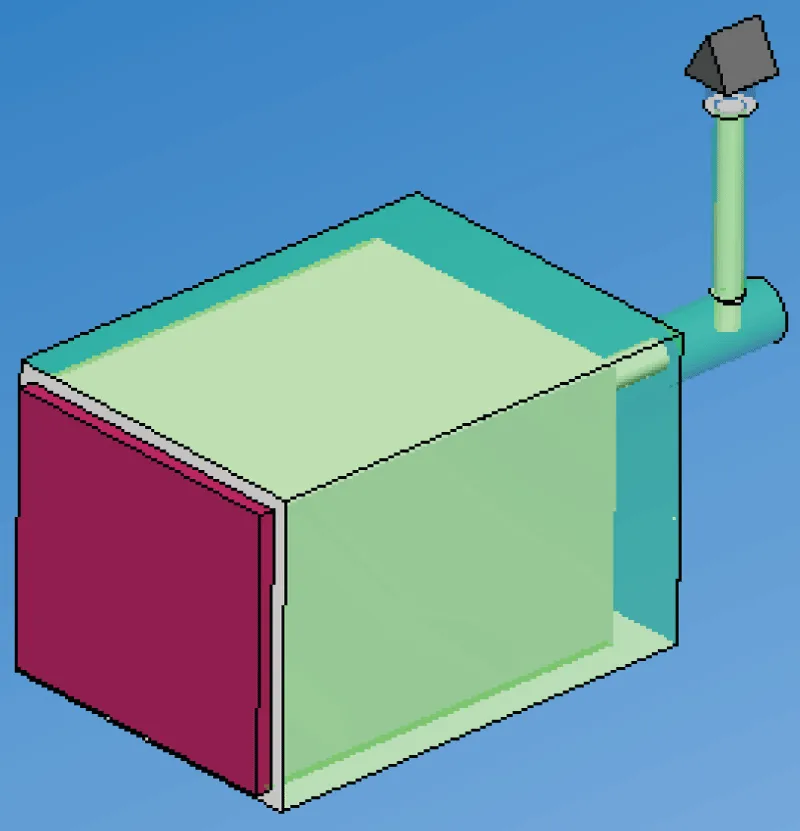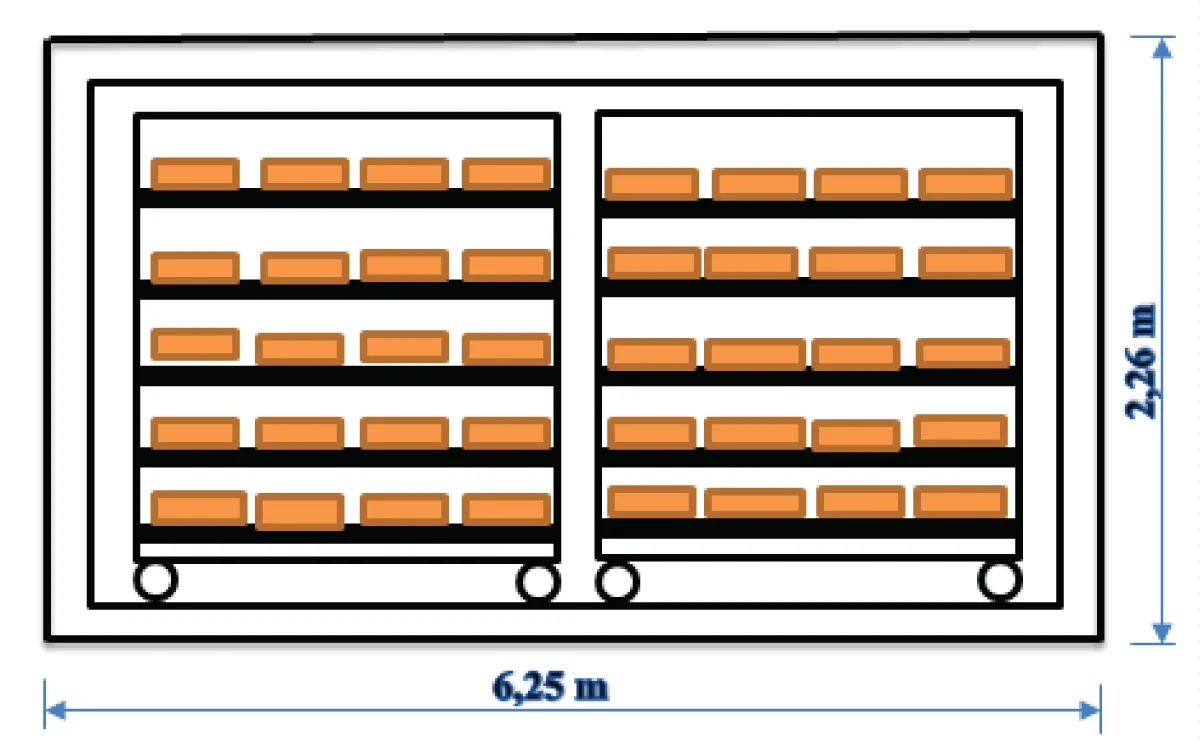
Modeling of an Electric-fired Brick Oven, Directly Heated
Energy Systems Materials Science受け取った 13 Feb 2024 受け入れられた 18 Mar 2024 オンラインで公開された 19 Mar 2024
ISSN: 2995-8067 | Quick Google Scholar


受け取った 13 Feb 2024 受け入れられた 18 Mar 2024 オンラインで公開された 19 Mar 2024
The purpose of this article is to propose a model of an electric-fired brick oven, with the aim of eliminating the imperfections presented by traditional brick ovens. To complete this study, we used the concepts of heat transfer, and material resistance, as well as those of computer-aided mechanical design.
Deemed satisfactory, the results found give a yield of 94.5% and a cooking time of 7.29 hours based on 2000 bricks cooked.
First of all, in order of appearance, here are the successive stages of the manufacture of fired bricks: Preparation of raw materials, Production of brick dough, Molding of bricks, drying of bricks, Cooking, and Cooling of bricks [1].
Cooking is the stage concerned by our study which, until now, is the traditional method with firewood or coal ovens which are used in the town of Boma in the Province of Kongo Central in the Democratic Republic of Congo. This results in environmental pollution through emissions of coal added to the ovens [2] and the deforestation of Boma and the surrounding villages. With a cooking time of more than 20 days for a very low production frequency.
The bricks are fired in an electric resistance oven with a cooking temperature of 950 °C for a cooking time of 7 hours.
The bricks are introduced into the baking chamber of the kiln using trolleys. This cooking chamber contains 4 carbon steel carts with 5 shelves each, whose heating resistors are placed below (each shelf) [3]. On each display will be placed 100 cooking bricks. This gives a total capacity of 2000 bricks per firing. The temperature inside the oven is measured using 8 portable digital thermometers (probes) capable of measuring temperatures with an accuracy of 0.1 LC, each placed on the bottom and top of each trolley.
The Figures show the oven Figures 1,2.
| Table 1: Calculation results of the different oven parameters: | |||
| Parameters | Values | Parameters | Values |
| 175711,91W | h | 94,5% | |
| 305220,958W | P | 724417,177W | |
| 555152,828W | tch | 0,006heure | |
| 277,297W | tcooking | 7,29 heures | |
| Qresist | 724417,177W | R | 425W |
| η is the energy efficiency of the oven, P is the installed oven power, tch is the heating time of the fired, tcooking is the cooking time and R is the resistance. | |||
Thermal balance: By application of the first law of thermodynamics, the inventory of the different heat flows in the oven is given by [4]:
(1)
Or Qresist is the power supplied by the resistors in W, is the power of the bricks at the entrance to the kiln in W, is the power of evaporation of the water contained in the bricks in the West the power of the bricks at the entrance to the kiln in W, is the power of the dry brick in W, is the power linked to the latent heat in W and Qlost is the power lost in W.
Knowing that convection and radiation are the two modes of heat transfer adopted for our model, the results of this study are displayed in Table 1.
In view of these results, we note that to bake 2000 bricks in baking chambers of identical dimensions (volume ~40 m3), our model which uses convection-radiation as a transfer mode, offers a reduction in cooking time which went from 20 days to 7.29 hours compared to the traditional oven. This sufficiently proves the good efficiency of this designed oven which is 94.5%.
We compared the results of this study with those of authors such as:
In 2021 regarding the cooking time, Kurmus and Mohajerani [5] according to their experience, found that the green brick samples were fired at 1050 °C for 3 h in the Thermoconcept electric chamber oven (model KC 220 /13, Hylec Controls Pty Ltd, NSW, Australia), which has a volume capacity of 0.216 m3.
Ettoumi, et al. [6] in 2020 during their study on the firing of bricks in a Nabertherm kiln concluded that only bricks fired at 1100 °C were classified as being of good quality with natural air convection for 24 hours. From the above, we see that the results of our study are satisfactory because the figures found are in the same order of grades as those authors cited above.
The research work carried out in this article is oriented towards environmental protection during the cooking stage in the manufacture of fired bricks. It was a question of designing an electric resistance oven, with a view to reducing deforestation and cooking time, improving the quality of the bricks after cooking, and increasing production compared to traditional kilns. Thus, after establishing the heat balance, the electric oven designed has a capacity of 2000 bricks for a total quantity of water to evaporate of 2800 kg under a useful power of 684.94 kW at a temperature of 950 °C for 7.29 hours making a cooking yield of 94.5%. This shows that the oven is almost well insulated and that most of the power generated is used for cooking. Replacing wood with electric resistance solves the pollution and deforestation problems mentioned above.
Kobor JD, Ndiaye LG, Touré M, Ndioukane R, Diédhiou A, Bayo A. Study of some physical and thermo-physical parameters of terracotta bricks at different temperatures. Conference Paper, May 2014.
Ncube A, Matsika R, Mangori L, Ulgiati S. Moving towards resource efficiency and circular economy in the brick manufacturing sector in Zimbabwe. International Journal of Cleaner Production. 2021; 281: 125238.
Benthani S. Numerical modeling of a forced convection electric oven. Memory. Trois-Rivières University of Quebec at Trois-Rivières. 2004; 116.
Jannot Y, Moyne C. 2nd year course: Thermal transfers. Ecole des MinesMines Nancy, 2012.
Kurmus H, Mohajerani A. Energy savings, thermal conductivity, micro and macro structural analysis of fired clay bricks incorporating cigarette butts. International Journal of Construction and Building. VIC. 3001; 2021; 376-392.
Ettoumi M, Jouini M, Neculita CM, Bouhlel S, Coudert L, Taha Y. Benzazoua M. Characterization of phosphate processing sludge from Tunisian mining basin and its potential valorization in fired bricks making. International journal of Journal of Cleaner Production. 2021; 284: 124750.
Mvuezolo AJN, Ngimbi JNL, Mbozi L. Modeling of an Electric-fired Brick Oven, Directly Heated. IgMin Res. Mar 19, 2024; 2(3): 143-144. IgMin ID: igmin157; DOI: 10.61927/igmin157; Available at: igmin.link/p157
次のリンクを共有した人は、このコンテンツを読むことができます:
Address Correspondence:
André-Jacques Nlandu Mvuezolo, Department of Electromechanics, Polytechnic Faculty, President Joseph Kasa-Vubu University, B.P. 314, Boma, Kongo Central, DR Congo, Email: [email protected]
How to cite this article:
Mvuezolo AJN, Ngimbi JNL, Mbozi L. Modeling of an Electric-fired Brick Oven, Directly Heated. IgMin Res. Mar 19, 2024; 2(3): 143-144. IgMin ID: igmin157; DOI: 10.61927/igmin157; Available at: igmin.link/p157
Copyright: © 2024 Mvuezolo AJN, et al. This is an open access article distributed under the Creative Commons Attribution License, which permits unrestricted use, distribution, and reproduction in any medium, provided the original work is properly cited.
 Figure 1: Furnace diagram...
Figure 1: Furnace diagram...
 Figure 2: Left view of the kiln with bricks on display....
Figure 2: Left view of the kiln with bricks on display....
 Table 1: Calculation results of the different oven paramete...
Table 1: Calculation results of the different oven paramete...
Kobor JD, Ndiaye LG, Touré M, Ndioukane R, Diédhiou A, Bayo A. Study of some physical and thermo-physical parameters of terracotta bricks at different temperatures. Conference Paper, May 2014.
Ncube A, Matsika R, Mangori L, Ulgiati S. Moving towards resource efficiency and circular economy in the brick manufacturing sector in Zimbabwe. International Journal of Cleaner Production. 2021; 281: 125238.
Benthani S. Numerical modeling of a forced convection electric oven. Memory. Trois-Rivières University of Quebec at Trois-Rivières. 2004; 116.
Jannot Y, Moyne C. 2nd year course: Thermal transfers. Ecole des MinesMines Nancy, 2012.
Kurmus H, Mohajerani A. Energy savings, thermal conductivity, micro and macro structural analysis of fired clay bricks incorporating cigarette butts. International Journal of Construction and Building. VIC. 3001; 2021; 376-392.
Ettoumi M, Jouini M, Neculita CM, Bouhlel S, Coudert L, Taha Y. Benzazoua M. Characterization of phosphate processing sludge from Tunisian mining basin and its potential valorization in fired bricks making. International journal of Journal of Cleaner Production. 2021; 284: 124750.